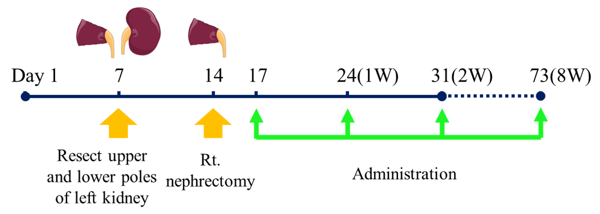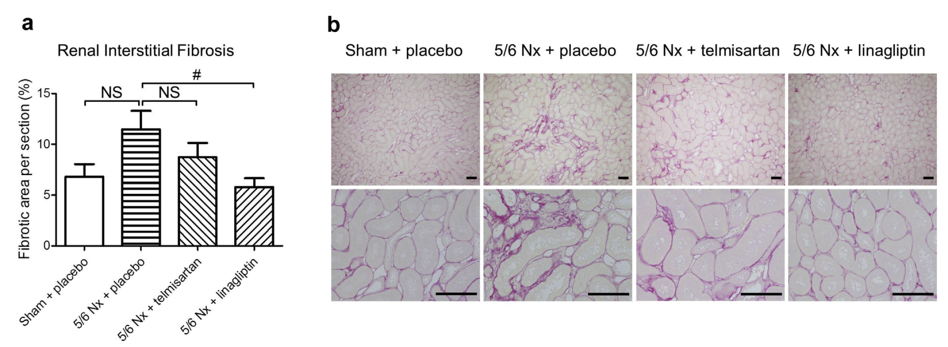5/6 Nephrectomy Model
Chronic kidney injury is a great risk factor for urology disease events and mortality. 5/6 nephrectomy model represents one of the most used animal models of chronic kidney injury in rodents. The reduction of renal mass is performed by either infarction or surgical excision of both poles, with removal of the contralateral kidney. It enables to investigate the effects of pharmacological, nutritive and other factors on functional and morphological renal parameters.
Application and advantages
Development of disease models could contribute to a better understanding of chronic kidney injury. Among the available disease models for chronic kidney injury, the 5/6 nephrectomy model has been a mainstay of studies of progressive renal disease. The remarkable features of 5/6 nephrectomy model in mice are common to chronic kidney injury observed in humans. Therefore, it has been used to test new therapies and develop related therapeutic drugs.
 Figure 1. The procedure of 5/6 nephrectomy model.
Figure 1. The procedure of 5/6 nephrectomy model.
Available Assays provided by Creative Bioarray include
- Clinical observations
body and remnant kidney weight, chow and water intake, 24 h urine volume - Renal morphometry and histological analysis
- Biochemical parameter analysis
- Plasma and urine analysis
- Hemodynamic measurements
Data & Figures
 Figure 2. Kidney morphology. (a) Renal interstitial fibrosis, (b) typical photomicrographs of the kidneys stained with sirius red for interstitial fibrosis.
Figure 2. Kidney morphology. (a) Renal interstitial fibrosis, (b) typical photomicrographs of the kidneys stained with sirius red for interstitial fibrosis.
Other urological disease models are also available:
Quotation and ordering
For more details, please do not hesitate to contact us.
Reference
Tsuprykov O et al. The dipeptidyl peptidase inhibitor linagliptin and the angiotensin II receptor blocker telmisartan show renal benefit by different pathways in rats with 5/6 nephrectomy. Kidney International, 2016, 89(5):1049-1061.
For research use only. Not for any other purpose.
Disease Models
- Oncology Models
-
Inflammation & Autoimmune Disease Models
- Rheumatoid Arthritis Models
- Glomerulonephritis Models
- Multiple Sclerosis (MS) Models
- Ocular Inflammation Models
- Sjögren's Syndrome Model
- LPS-induced Acute Lung Injury Model
- Peritonitis Models
- Passive Cutaneous Anaphylaxis Model
- Delayed-Type Hypersensitivity (DTH) Models
- Inflammatory Bowel Disease Models
- Systemic Lupus Erythematosus Animal Models
- Oral Mucositis Model
- Asthma Model
- Sepsis Model
- Psoriasis Model
- Atopic Dermatitis (AD) Model
- Scleroderma Model
- Gouty Arthritis Model
- Carrageenan-Induced Air Pouch Synovitis Model
- Carrageenan-Induced Paw Edema Model
- Experimental Autoimmune Myasthenia Gravis (EAMG) Model
- Graft-versus-host Disease (GvHD) Models
-
Cardiovascular Disease Models
- Surgical Models
- Animal Models of Hypertension
- Venous Thrombosis Model
- Atherosclerosis model
- Cardiac Arrhythmia Model
- Hyperlipoidemia Model
- Doxorubicin-induced Heart Failure Model
- Isoproterenol-induced Heart Failure Model
- Arterial Thrombosis Model
- Pulmonary Arterial Hypertension (PAH) Models
- Heart Failure with Preserved Ejection Fraction (HFpEF) Model
-
Neurological Disease Models
- Alzheimer's Disease Modeling and Assays
- Seizure Models
- Parkinson's Disease Models
- Ischemic Stroke Models
- Acute Spinal Cord Injury (ASCI) Model
- Traumatic Brain Injury (TBI) Model
- Hypoxic-Ischemic Encephalopathy (HIE) Model
- Tourette Syndrome (TS) Model
- Amyotrophic Lateral Sclerosis (ALS) Model
- Huntington's Disease (HD) Model
- Intracerebral hemorrhage (ICH) Models
- Schizophrenia Model
- Pain Models
-
Metabolic Disease Models
- Type 1 Diabetes Mellitus Model
- Type 2 Diabetes Mellitus Model
- Animal Model of Hyperuricemia
-
Nonalcoholic Fatty Liver Disease Model
- High-Fat Diet-Induced Nonalcoholic Fatty Liver Disease (NAFLD) Model
- Methionine and Choline Deficient (MCD) Diet-Induced Nonalcoholic Fatty Liver Disease (NAFLD) Model
- Gubra-Amylin NASH (GAN) Diet-Induced Nonalcoholic Fatty Liver Disease (NAFLD) Model
- Streptozotocin (STZ) Induced Nonalcoholic Fatty Liver Disease (NAFLD) Model
- High Fat Diet-Induced Obesity Model
- Diabetic Foot Ulcer (DFU) Model
- Liver Disease Models
- Rare Disease Models
- Respiratory Disease Models
- Digestive Disease Models
-
Urology Disease Models
- Cisplatin-induced Nephrotoxicity Model
- Unilateral Ureteral Obstruction Model
- 5/6 Nephrectomy Model
- Renal Ischemia-Reperfusion Injury (RIRI) Model
- Diabetic Nephropathy (DN) Models
- Passive Heymann Nephritis (PHN) Model
- Adenine-Induced Chronic Kidney Disease (CKD) Model
- Kidney Stone Model
- Doxorubicin-Induced Nephropathy Model
- Orthotopic Kidney Transplantation Model
- Orthopedic Disease Models
- Ocular Disease Models
- Skin Disease Models
- Infectious Disease Models
- Otology Disease Models